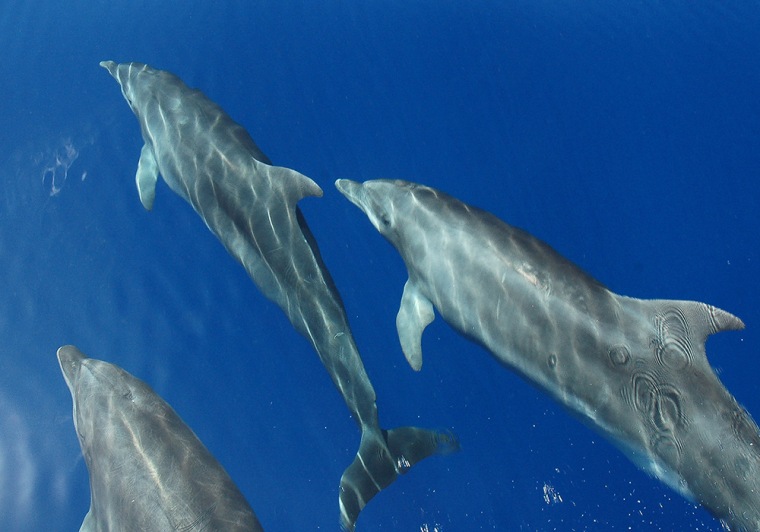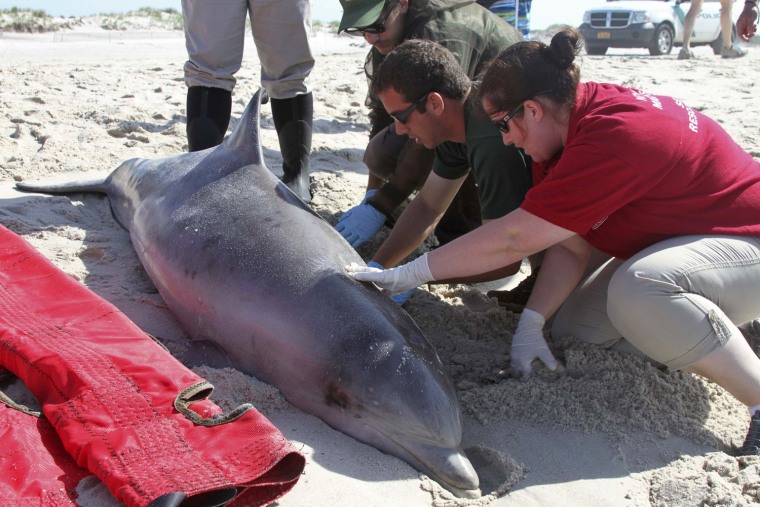
A silent, mysterious plague is claiming the lives of scores of bottlenose dolphins off the mid-Atlantic coast. Over July and August so far, 228 dead or dying dolphins have washed up on beaches from New Jersey to Virginia, and the numbers continue to climb.
The dead include adult animals and calves, males and females. Sometimes, the animals that wash ashore are dead for days. Others arrive on their last breath. None have survived.
The National Oceanic and Atmospheric Administration has formally classified the mass deaths as an "Unusual Mortality Event." The daily arrival of dead dolphins is an ominous sign of a larger, ailing coastal ecosystem, researchers say. It could even signal the return of a deadly sickness that raged for 10 months in the late 1980s, and felled more than 700 bottlenoses before the carnage ended.
"We started getting really alarmed by July 25, when we started getting more than one animal per day. That was the tipping point," Susan Barco, a researcher at the Virginia Aquarium Marine Mammal Center, told NBC News.
August usually brings about seven strandings to the Virginia shores, but this month, with two weeks to go, Barco has already counted 75 dead dolphins. And calls about new strandings are flooding in daily. "There are days when we cannot get off the phone," she said. "Everyone loves dolphins ... they're certainly concerned."
Of the world's 600,000 dolphins, up to 22,800 coastal migrators — some heading south, to the Carolinas for the winter, and others heading north — are expected to pass through the mid-Atlantic in the summer and fall. "We are worried that ... the elevated strandings will not stop until the dolphins leave our area," Barco said.
Researchers across the U.S. have rallied to support the investigation, at labs, at stranding sites, and at other remote locations. If volunteers find a recently dead animal — a carcass in good shape — they drive them to the aquarium lab facility. There, a team of three or four researchers works for about seven hours collecting swabs, tissue samples, body fluids — material that can be probed for viral or bacterial pathogens. Genetic tests are also on the to-do list.
From whole animals, Barco has recorded respiratory infections, joint infections, skin and mouth lesions. Some animals appear emaciated, as if they suddenly went off their food. But the real killer — likely a bacteria or virus of some kind — is still at large.

Prime suspect: Morbillivirus
Chief among the suspected "causal agents" is the morbillivirus, a bug that turned up in the tissue of one dead New Jersey dolphin. It's still too early to say if the virus killed that animal, much less the rest of the herds.
Morbillivirus does have a track record, however. This virus was behind another mass die-off that claimed the lives of more than 700 dolphins between June 1987 and March 1988. The morbillivirus in that event wasn't found until years later, but the experts say technological progress will help identify the cause faster in this case.
How did those dolphins get so sick a quarter century ago? One theory, Barco explained, is that the coast-dwelling dolphin population caught the virus through exchanging breathed air or body fluids with dolphins that live in deeper waters. The offshore herds are believed to harbor the virus without getting ill from it, unlike their unfortunate coastal cousins.
"Looking at this event from 10,000 feet in the air, it looks much the same as 1987," Charles Potter, collections manager of marine mammals at the Smithsonian's National Museum of Natural History, told NBC News. But, he added, further tests are needed "before we can say if this a repeat or if this is just something that looks similar."
Because of the NOAA Unusual Mortality Event classification, dolphin experts have access to a deeper pool of funding for tools, equipment and salaries for investigation. But budgetary belts are tighter than ever, and this doesn't mean carte blanche. Currently, there is $200,000 available in funding for seven open cases, said one NOAA marine biologist. This mass death is just one of those cases.
Though fatigue is already setting in, experienced marine biologists know this may only be the beginning. Potter, who also helped research the 1980s die off, traveled down to the Virginia Aquarium to help with dolphin necropsies. "All of us would hope that this mortality would just cease. But I don't think it's going to happen," Potter said.
A few weeks in, with a long fall ahead, the work is already taking a toll on the humans involved. "We are alarmed and concerned and exhausted," Barco said.
Have you seen a stranded dolphin? NOAA has the following safety tips:
- Do not touch the dolphin.
- Don’t allow pets to approach the dolphin.
- Observe the animal from a safe distance of 100 yards (safe for you and the animal)
If you see a dead or stranded dolphin in New York, call the Riverhead Foundation's 24-hour rescue hotline at 631-369-9829. If you're in New Jersey contact the Marine Mammal Stranding Center's hotline at 609-266-0538.
Nidhi Subbaraman writes about technology and science. Follow her on Facebook, Twitter and Google+.